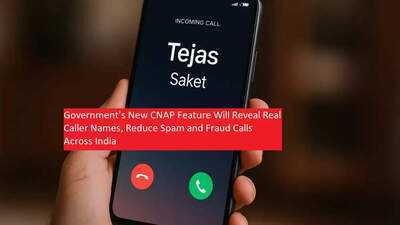
The days of guessing who might be calling from an unknown number are coming to an end. The Government of India is currently testing a powerful new feature called CNAP (Calling Name Presentation), which is designed to display the official name of the caller on your phone screen—even if you haven’t saved their number. This upcoming system could significantly reduce spam, scam and fraudulent calls that trouble millions of mobile users every day.
What Exactly Is CNAP and How Does It Work?CNAP is a government-backed caller identification system that functions somewhat like Truecaller, but with one major difference—the names are pulled directly from verified government records. When you buy a SIM card in India, you are required to submit ID proof with your real name. CNAP uses this official information to display the caller’s registered name.
Here’s how the process works when a call arrives:
First, your phone will show the government-recorded name of the caller.
After a brief moment, the display will switch to the name you have saved in your contact list (if you have saved one).
For example, suppose you saved someone’s number as “Saket,” but their official name is “Tejas.” When they call you, CNAP will first show “Tejas,” and only a moment later will it show “Saket,” the name you assigned. This ensures that every user gets a verified identity before deciding to answer the call.
This government-driven verification model helps avoid situations where people use fake names or misleading tags, something that often happens on third-party caller ID apps.
Why Is CNAP Being Introduced?Spam and fraudulent calls have become a major concern across India. Cybercriminals and scammers often use unknown or spoofed numbers to trick people into sharing personal or financial information. Until now, users relied heavily on apps like Truecaller, which crowdsource data from other users—meaning the name displayed could be inaccurate or even intentionally misleading.
CNAP solves this issue by offering:
Verified caller names directly from government records
Higher trust in incoming calls
Reduced chances of falling for fraud or phishing attempts
Greater transparency while receiving calls from unknown numbers
This system aims to create a safer communication environment where people can answer calls with more confidence and less fear of scams.
Where Is CNAP Being Tested and When Will It Launch Nationwide?The Department of Telecommunications (DoT) approved CNAP last month, and telecom operators have already begun pilot testing it in select regions. The trials are evaluating how quickly and accurately the names appear, how the feature interacts with various devices and networks, and whether it affects call quality.
If the testing phase progresses smoothly, CNAP could soon roll out across the entire country, becoming a default feature for all mobile users—regardless of their telecom provider.
Concerns About Privacy and Name DisplayWhile CNAP promises accuracy and safety, it has also sparked important privacy questions. Users are curious about:
How they can update their name in the system
Whether they can hide or mask their name
What happens if someone wants to display a preferred name instead of their legal name
Discussions are ongoing, and the government is exploring options that balance transparency with individual privacy rights. Any final implementation will likely include mechanisms for name updates and corrections.
A Safer Communication Future for IndiaOnce fully launched, CNAP could transform the way Indians handle incoming calls. No more guessing who is calling or relying on crowd-fed apps that may display incorrect identities. Instead, users will see trusted, government-verified names, making call screening faster, easier and safer.
With spam and fraud calls rising every year, CNAP promises to be a powerful tool for digital security and consumer protection. Soon, picking up a call from an unknown number may no longer feel risky—but reassuring.